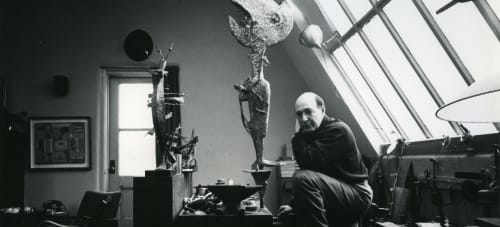Herbert Ferber Silvers was born on April 30, 1906, in New York. He studied physical sciences and the humanities at the College of the City of New York (CCNY) from 1923 to 1927, when he received a BS from a joint program with CCNY and Columbia University. From 1927 to 1930 Ferber attended night classes in sculpture at the Beaux-Arts Institute of Design, and for six months in 1930 studied at the National Academy of Design. In 1930 he graduated from the College of Oral and Dental Surgery at Columbia. He practiced dentistry and taught part-time at the Columbia Dental School during the 1930s.
By 1931 Ferber was committed to making sculpture, initially carving in wood and stone. In 1935 he joined New York's Midtown Galleries, followed by his taking part in the first American Artists' Congress and membership in the Artists' Union in 1936. The Midtown Galleries organized his solo debut in 1937. Informed by a political consciousness reflecting the times, Ferber's work from this period is primarily figurative and imagistic. In 1940 he joined a group of anti-Stalinist artists, including Ilya Bolotowsky, Adolph Gottlieb, Mark Rothko, Meyer Schapiro, David Smith, and Bradley Walker Tomlin in splintering off from the American Artists' Congress, a primarily Communist group, and founding the Federation of Modern Painters and Sculptors.
Ferber began to depart from his practice of carving in 1940 with his first attempts to make wood sculpture by attaching elements with glue and dowels. In 1944 he created his last work in wood, and in 1945, influenced by Henry Moore's works on view at Curt Valentin's New York gallery, Ferber experimented with steel-reinforced concrete in order to achieve greater open spaces in his works. He then produced his first abstract sculptures, as well as his first soldered metal works. From 1946 to 1947, the artist increasingly associated with Abstract Expressionist painters and also frequented Peggy Guggenheim's Art of This Century gallery-museum. He began to more fully appreciate Surrealism's impact on his work.
In 1950, Ferber became associated with the artists later dubbed the Irascibles for protesting the conservative jury of a painting exhibition at the Metropolitan Museum of Art, as well as a charter member of the Club, a group of avant-garde artists who gathered in Greenwich Village to discuss and debate art. Around this time he was commissioned to create a sculptural work for the facade of B'nai Israel Synagogue, Millburn, New Jersey, with Gottlieb and Robert Motherwell brought in to make paintings for the interior. Titled And the bush was not consumed . . . , the relief work marked a significant discovery for Ferber. During the nine months he worked on the piece, and particularly during the installation, he moved in and around the elements, appreciating the viewer's role in activating and defining space. The work was completed in 1952, but he continued to explore the possibilities of viewer interaction with works such as Game No. 2 (1950), in which the individual parts can be interchanged and realigned with the base. In 1956, Ferber was among the artists who signed a letter of protest against the curvilinear slope of Frank Lloyd Wright's planned building for the Guggenheim Museum, challenging its defiance of the traditional rectilinear forms and presentation of painting and sculpture.
Throughout the 1950s, Ferber established, in lectures and exhibitions, his role as a theorist and creator of direct metal sculpture, and by 1961 he had spoken widely on site-specific sculpture. For the Whitney Museum of American Art, New York, in 1961, Ferber created a work that is considered one of the first indoor environmental installations. Titled Sculpture as Environment, the fiberglass piece filled an entire room, and visitors could enter its interior spaces. The artist continued to work with abstract forms, mostly on a large scale, in the 1970s and 1980s. His first major retrospective was held at the Walker Art Center, Minneapolis (1962). His work as a teacher included visiting professorships at the University of Pennsylvania, Philadelphia (1962–63), and Rutgers University, New Jersey (1965–67). Ferber died of cancer on August 20, 1991, at his summer home in Egremont, Massachusetts.

